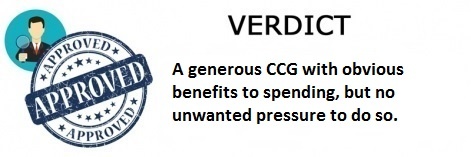Welcome back to the In-App Purchase Inspector - our regular look at free-to-play games from the consumer's perspective.
In each instalment, we consider the incentives or pressure applied to make in-app purchases, their perceived value, the expansion offered by IAPs and the overall value of the experience.
The end goal is to see whether the game makes a good enough case for us to part with our cash, or whether players are content - or engaged enough - to 'freeload'.
This time, we're taking a look at The Elder Scrolls: Legends, Dire Wolf Digital and Bethesda's take on the Hearthstone formula using its best-loved IP.
Romanced by the 'stone
For many, The Elder Scrolls: Legends has felt like Bethesda's attempt to cash in on the success of Hearthstone since its announcement way back in July 2015.
And now it's finally here, the similarities are plain to see. However, with Hearthstone the clear market leader, these are to be expected. What's more interesting are the points of divergence.
The biggest is the fact that play takes place across two lanes in The Elder Scrolls: Legends, meaning you have to fight (and think) on more than one front.
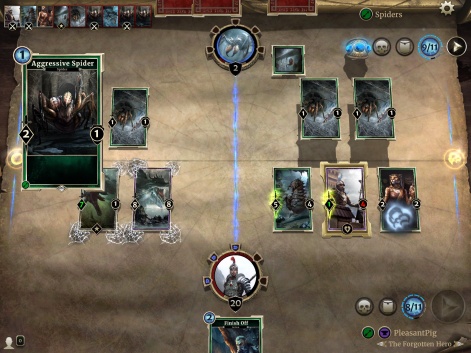
Another new aspect, which sounds small but has a big effect on the flow of matches, is that each player draws a new card every time they lose five HP, contributing to an enjoyable back-and-forth.
The Elder Scrolls: Legends follows in Hearthstone's footsteps by approaching monetisation with a light touch.
It's not a revolution, but it mixes up the formula far more than many would have been expecting, certainly not resting on its laurels and relying on The Elder Scrolls name to lure in players.
Pay if you want
As far as monetisation is concerned, The Elder Scrolls: Legends follows in Hearthstone's footsteps by approaching it with a light touch.
This means building monetisation around optional card packs, eschewing energy systems or any other mechanic that restricts play for the non-paying user.
Gold is the soft currency, earned for completing stages in the Story Mode and for completing daily quests - rewards for which are worth 40 to 50 Gold.
To contextualise this, 100 Gold is enough to buy a single Core Set Pack, containing six cards.
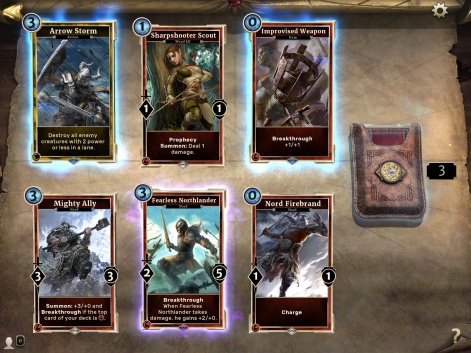
This is how non-payers will be bolstering their decks. And with no hard currency in sight, greater quantities of packs are simply priced in real money - ranging from $2.99 for two Core Set Packs to $69.99 for 60 of them.
There are also special offers, including a Starter Pack which offers pretty great value: 10 Core Set Packs, a unique title for your avatar (a kind of VIP reward), three playsets of exclusive premium art cards and a bonus Legendary card for $4.99.
A little friction
Working up enough Gold to buy the occasional Core Set Pack will be enough for most players to accumulate a deck suited to their needs,
But for those who do decide to spend, one small point of friction is that a Bethesda account is required in order to make a purchase.
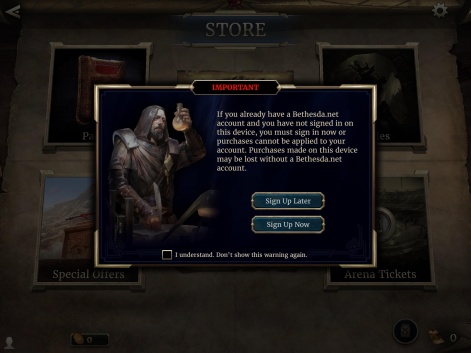
An uncommon practice in the world of mobile gaming, although Blizzard operates the same system with Hearthstone, it's a curious choice for a platform on which streamliming the experience is the key.
An offer of three free Core Set Packs is offered as an incentive for linking an account.
Not selling its Soul
Functionally, the closest resource to a hard currency in The Elder Scrolls: Legends is Soul Gems. These can be used to buy individual cards - 50 for a Common, 100 for a Rare and 400 for Epic.
However, they cannot be purchased with real money. Instead, you can get Soul Gems as rewards in the Solo and Versus Arena, for winning in Practice Mode (five for Novice difficulty, 10 for Adept, 15 for Expert) and by using Soul Trap to convert unwanted cards into Soul Gems.
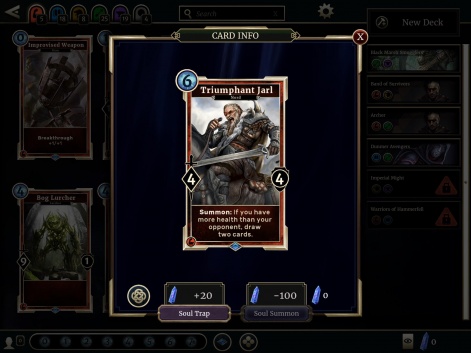
And so, the loop for the majority of players will be simple: complete daily quests to earn enough Gold for a new Core Set Pack every couple of days, while saving up Soul Gems for those much-needed additions by purging unwanted cards and playing in practice mode.
There's no hard sell here - after all, Hearthstone has proven that it's possible to be plenty profitable without such tactics - and I personally haven't been tempted to spend yet.
However, as reflected in the lengthy beta period, Bethesda is thinking long-term with The Elder Scrolls: Legends. It will be the hardcore fans to whom the IAPs appeal, and this is the group that will keep the game competitive and thriving down the line.
I may not fit that group right now, but as long as Bethesda keeps its players sticking around, who's to say that I - and players like me - won't eventually be tempted to spend?
The Elder Scrolls: Legends has enough of a battle on its hands in a crowded CCG space. Not picking another with its players is among its wisest moves.
